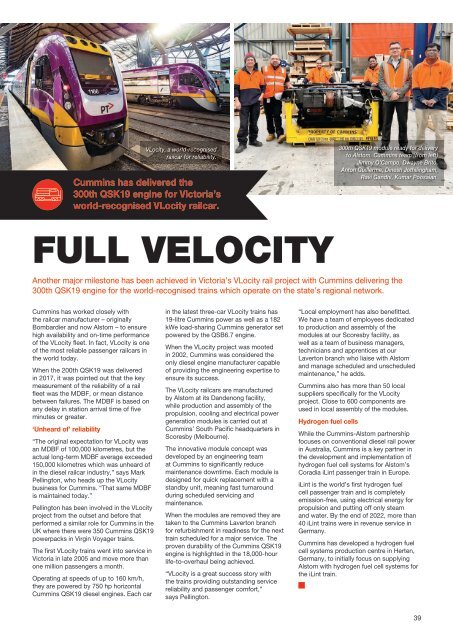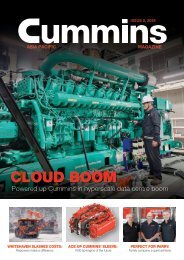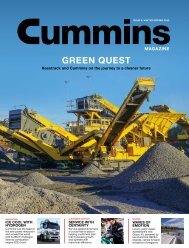Cummins Asia Pacific Magazine - Issue 1 2023
The 2023 edition of the Cummins Magazine for Asia Pacific is now available!
The 2023 edition of the Cummins Magazine for Asia Pacific is now available!
You also want an ePaper? Increase the reach of your titles
YUMPU automatically turns print PDFs into web optimized ePapers that Google loves.
VLocity, a world-recognised<br />
railcar for reliability.<br />
<strong>Cummins</strong> has delivered the<br />
300th QSK19 engine for Victoria’s<br />
world-recognised VLocity railcar.<br />
300th QSK19 module ready for delivery<br />
to Alstom. <strong>Cummins</strong> team (from left)<br />
Jimmy O’Campo, Dwayne Brito,<br />
Anton Guillerme, Dinesh Jothilingham,<br />
Ravi Gandhi, Kumar Poosalan.<br />
FULL VELOCITY<br />
Another major milestone has been achieved in Victoria’s VLocity rail project with <strong>Cummins</strong> delivering the<br />
300th QSK19 engine for the world-recognised trains which operate on the state’s regional network.<br />
<strong>Cummins</strong> has worked closely with<br />
the railcar manufacturer – originally<br />
Bombardier and now Alstom – to ensure<br />
high availability and on-time performance<br />
of the VLocity fleet. In fact, VLocity is one<br />
of the most reliable passenger railcars in<br />
the world today.<br />
When the 200th QSK19 was delivered<br />
in 2017, it was pointed out that the key<br />
measurement of the reliability of a rail<br />
fleet was the MDBF, or mean distance<br />
between failures. The MDBF is based on<br />
any delay in station arrival time of five<br />
minutes or greater.<br />
‘Unheard of’ reliability<br />
“The original expectation for VLocity was<br />
an MDBF of 100,000 kilometres, but the<br />
actual long-term MDBF average exceeded<br />
150,000 kilometres which was unheard of<br />
in the diesel railcar industry,” says Mark<br />
Pellington, who heads up the VLocity<br />
business for <strong>Cummins</strong>. “That same MDBF<br />
is maintained today.”<br />
Pellington has been involved in the VLocity<br />
project from the outset and before that<br />
performed a similar role for <strong>Cummins</strong> in the<br />
UK where there were 350 <strong>Cummins</strong> QSK19<br />
powerpacks in Virgin Voyager trains.<br />
The first VLocity trains went into service in<br />
Victoria in late 2005 and move more than<br />
one million passengers a month.<br />
Operating at speeds of up to 160 km/h,<br />
they are powered by 750 hp horizontal<br />
<strong>Cummins</strong> QSK19 diesel engines. Each car<br />
in the latest three-car VLocity trains has<br />
19-litre <strong>Cummins</strong> power as well as a 182<br />
kWe load-sharing <strong>Cummins</strong> generator set<br />
powered by the QSB6.7 engine.<br />
When the VLocity project was mooted<br />
in 2002, <strong>Cummins</strong> was considered the<br />
only diesel engine manufacturer capable<br />
of providing the engineering expertise to<br />
ensure its success.<br />
The VLocity railcars are manufactured<br />
by Alstom at its Dandenong facility,<br />
while production and assembly of the<br />
propulsion, cooling and electrical power<br />
generation modules is carried out at<br />
<strong>Cummins</strong>’ South <strong>Pacific</strong> headquarters in<br />
Scoresby (Melbourne).<br />
The innovative module concept was<br />
developed by an engineering team<br />
at <strong>Cummins</strong> to significantly reduce<br />
maintenance downtime. Each module is<br />
designed for quick replacement with a<br />
standby unit, meaning fast turnaround<br />
during scheduled servicing and<br />
maintenance.<br />
When the modules are removed they are<br />
taken to the <strong>Cummins</strong> Laverton branch<br />
for refurbishment in readiness for the next<br />
train scheduled for a major service. The<br />
proven durability of the <strong>Cummins</strong> QSK19<br />
engine is highlighted in the 18,000-hour<br />
life-to-overhaul being achieved.<br />
“VLocity is a great success story with<br />
the trains providing outstanding service<br />
reliability and passenger comfort,”<br />
says Pellington.<br />
“Local employment has also benefitted.<br />
We have a team of employees dedicated<br />
to production and assembly of the<br />
modules at our Scoresby facility, as<br />
well as a team of business managers,<br />
technicians and apprentices at our<br />
Laverton branch who liaise with Alstom<br />
and manage scheduled and unscheduled<br />
maintenance,” he adds.<br />
<strong>Cummins</strong> also has more than 50 local<br />
suppliers specifically for the VLocity<br />
project. Close to 600 components are<br />
used in local assembly of the modules.<br />
Hydrogen fuel cells<br />
While the <strong>Cummins</strong>-Alstom partnership<br />
focuses on conventional diesel rail power<br />
in Australia, <strong>Cummins</strong> is a key partner in<br />
the development and implementation of<br />
hydrogen fuel cell systems for Alstom’s<br />
Coradia iLint passenger train in Europe.<br />
iLint is the world’s first hydrogen fuel<br />
cell passenger train and is completely<br />
emission-free, using electrical energy for<br />
propulsion and putting off only steam<br />
and water. By the end of 2022, more than<br />
40 iLint trains were in revenue service in<br />
Germany.<br />
<strong>Cummins</strong> has developed a hydrogen fuel<br />
cell systems production centre in Herten,<br />
Germany, to initially focus on supplying<br />
Alstom with hydrogen fuel cell systems for<br />
the iLint train.<br />
39





